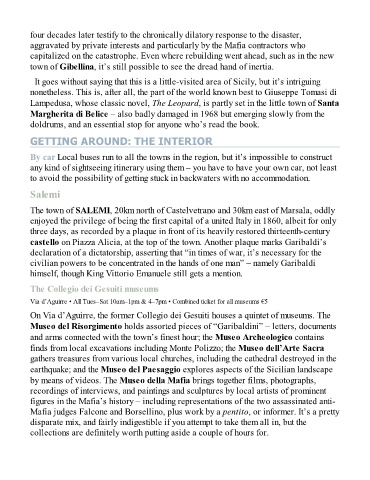Page 542 - The Rough Guide of Sicily
P. 542
four decades later testify to the chronically dilatory response to the disaster,
aggravated by private interests and particularly by the Mafia contractors who
capitalized on the catastrophe. Even where rebuilding went ahead, such as in the new
town of Gibellina, it’s still possible to see the dread hand of inertia.
It goes without saying that this is a little-visited area of Sicily, but it’s intriguing
nonetheless. This is, after all, the part of the world known best to Giuseppe Tomasi di
Lampedusa, whose classic novel, The Leopard, is partly set in the little town of Santa
Margherita di Belice – also badly damaged in 1968 but emerging slowly from the
doldrums, and an essential stop for anyone who’s read the book.
GETTING AROUND: THE INTERIOR
By car Local buses run to all the towns in the region, but it’s impossible to construct
any kind of sightseeing itinerary using them – you have to have your own car, not least
to avoid the possibility of getting stuck in backwaters with no accommodation.
Salemi
The town of SALEMI, 20km north of Castelvetrano and 30km east of Marsala, oddly
enjoyed the privilege of being the first capital of a united Italy in 1860, albeit for only
three days, as recorded by a plaque in front of its heavily restored thirteenth-century
castello on Piazza Alicia, at the top of the town. Another plaque marks Garibaldi’s
declaration of a dictatorship, asserting that “in times of war, it’s necessary for the
civilian powers to be concentrated in the hands of one man” – namely Garibaldi
himself, though King Vittorio Emanuele still gets a mention.
The Collegio dei Gesuiti museums
Via d’Aguirre • All Tues–Sat 10am–1pm & 4–7pm • Combined ticket for all museums €5
On Via d’Aguirre, the former Collegio dei Gesuiti houses a quintet of museums. The
Museo del Risorgimento holds assorted pieces of “Garibaldini” – letters, documents
and arms connected with the town’s finest hour; the Museo Archeologico contains
finds from local excavations including Monte Polizzo; the Museo dell’Arte Sacra
gathers treasures from various local churches, including the cathedral destroyed in the
earthquake; and the Museo del Paesaggio explores aspects of the Sicilian landscape
by means of videos. The Museo della Mafia brings together films, photographs,
recordings of interviews, and paintings and sculptures by local artists of prominent
figures in the Mafia’s history – including representations of the two assassinated anti-
Mafia judges Falcone and Borsellino, plus work by a pentito, or informer. It’s a pretty
disparate mix, and fairly indigestible if you attempt to take them all in, but the
collections are definitely worth putting aside a couple of hours for.

